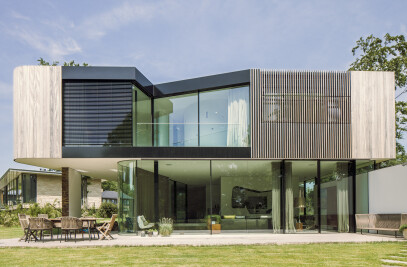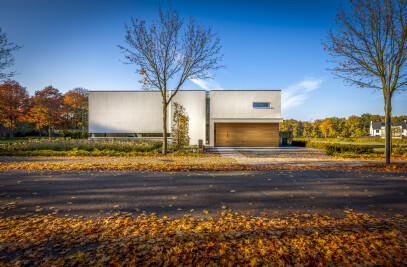Ecological concept Generating its own energy
The aim of the ecological concept is to achieve a zero emission house which can generate its own energy needs:
- It generates its own electricity from sun energy by the use of solar panels - It collects earth heat or cold from the ground and stores it in the ground for additional heating or cooling - It collects its own water with an own dug underground well - It collects rainwater and reuses it for flushing the toilets
Reducing energy needs In order to reduce the required energy for heating or cooling we propose a house which makes more use of the thermal earth warmth. An underground house can make use of the constant earth temperature of 15 degrees Celsius and therefore need less energy for heating or cooling to reach the required interior temperature of around 19 degrees Celsius.
A house above the ground can absorb the extra warmth or cold in summer or cold in winter. A combination of both principles could lead to a more energy saving house. The extra warmth or cold can be mixed with air of the underground house to achieve the required temperature.
A combination of an “underground-” and “above the ground“ house would lead to a section where you have underground rooms (more dark and cool) and above the ground rooms (more light, different temperature).
How can sustainability trigger architecture and life?
An eco house contributes to the environment. Does it also contribute to the quality of the daily life?
Back to basic: experiences of nature
As a child it was a great experience going up and down the slide. As adults we are conditioned to go up and down the stairs. Where is the joy of moving? As a child it was a great experience to build underground shacks. There we would sit tight to each other, in contact with the earth, in the dark, in our own world, safe from the outside. Why as grown up people do we want bigger spaces and let technique give us protection, such as alarm systems. For children, playing in the rain could be an exciting thing. For adults we usually don't like getting wet in the rain, but we do enjoy rain showers.
Maybe designing elements with more joy can bring more quality of the daily life.
Designing experiences
Daily life cycle The spaces described in the “underground-” and “above the ground“ house match perfectly with the daily life cycle. The more darker and sheltered spaces for sleeping can be located in the “underground” house: dark and sheltered from the outside world. The more light area for living can be located in the “above the ground“ house: more in contact with light and surroundings. The design consist of four stories ranging from dark to light.
Bedstead Reintroducing the bedstead in the “underground” house could strengthen the experience of intimate space in the dark, protected from the outside world.
The glide The four stories in the eco “underground-” and “above the ground“ house are connected by a set of stairs. By introducing also a glide, travelling down to the underground house could be more an experience. It also is a time saving element were traveling might become a joyful experience.
Rain shower An open gap in the roof could function as a rain shower when it rains, where the strength of water flows depend on nature. Going to the shower could be an adventure where you can get cleansed by natural rain.
Toilet lounge Visiting the toilet is mostly an individual boring ritual. By clustering more toilets to meet each other in the toilet could lead to a social event and maybe more quality time.
Design of the eco house This eco house is a design which contributes to the environment. The design generates its own energy. This home also requires less energy for heating or cooling compared to a traditional house. The design is also a speculation to give a different view of a living environment to bring back more basic experiences with nature. It is also an attempt to introduce opportunities for new social interactions, in order to gain more quality in daily life.
ECO from a different angle… In a time when words like sustainable, ecological and green are almost an obligation, they are often only used as a label. That is why one of our latest 123DV projects proved to be challenging, but also very exciting: we were asked to design an ECO House. Thanks to our friends from Mode:Lina we were involved in a Polish design competition. The assignment was clear and simple: design a house for a standard family, on a standard location, but with a highly sustainable performance.
We had faced this topic before in previous projects, but it had not yet been used as the core of the design. For this competition we were asked to be bold, to push to the boundaries of sustainability. It took us several brainstorm sessions to find the right strategy, but at the end we all agreed on one thing: our answer to the question should be architectural. Since we are not engineers, biologists or scientists, we had to look at it from an architectural point of view: does the house contribute to the quality of daily life?
As architects, we deal with space, organization, shapes, light, materials… So we took a basic shape (rectangle), used an age-old natural and ecological recourse (geothermal heat) and combined the two. The house is a rectangle of 28 by 9 by 4.3 meters that for two thirds has been plugged into the ground under an angle of 21 degrees! With one gesture, we created both a strong visual statement and a high performance energy standard. Simple, strong and efficient, but not without consequence. We also had to deal with the psychological impact of living in a sloped house, underneath the ground and with little natural light. The task wasn’t easy, but in the end we managed to transform the problems into opportunities and create a unique and special ECO house.

































